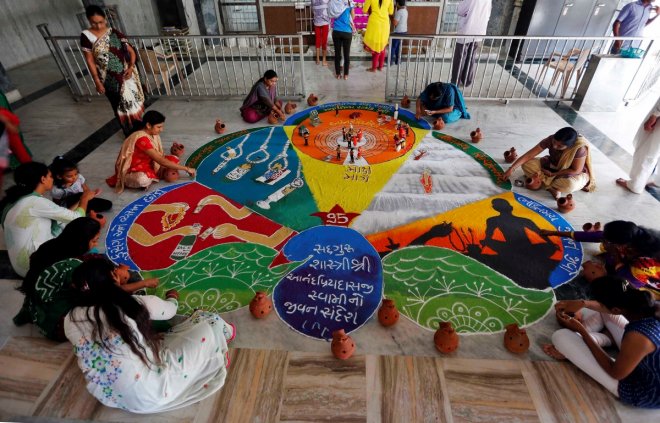
People of Indian descent everywhere in the world celebrate Deepavali, or Divali, with aplomb this weekend. The festival of lights that derives its name from deepam that means light and avail, which means 'row' is the biggest celebration in the Hindu calendar and is universally celebrated by Hindus across the globe.
When is festival of lights celebrated?
Deepavali is celebrated over several days, with each day signifying a certain aspect of the many layered mythological meanings behind the festival. This year the main festival falls on Sunday October 30, as per calculations in the Hindu lunar calendar.
Precursor of Halloween traditions?
Like the quintessential Hindu faith itself, Deepavali, also spelt as Diwali, represents many things and is steeped in multifarious beliefs, traditions, customs and myths. It's a harvest festival prevalent from the ancient times, it's seen as the celebration of the ultimate victory of good over evil, it symbolizes prosperity and wealth. In some modern reading of the ontological base of the festival, parallels have even been drawn between the western festival of Halloween, which is basically premised on the artful ways of getting the better of the lurking evil-- albeit in an unserious manner.
The many stories of Deepavali
Essentially Deepavali is all about celebrating life -- abundance over paucity, light over darkness, life over death, new over old, health over pestilence, and the like. And then, while the universal themes of Diwali -- light, prosperity, goodness and cheer -- are the same, the customs, the characters and the traditions differ.
The most popular religious mooring of Deepavali is the tale of Lord Rama's epochal battle with 10-headed demon king Raavana over the majestic Sita Devi. After the Lord vanquished the netherworld demon, his folks gave him a rousing welcome in Ayodhya, lighting a thousand lamps, or diyas, in little clay urns and lining them up in rows.
Another story is about how Lord Vishnu took the avatar or incarnation of Vaamana the Dwarf to spare the gods from the unceasing trouble from King Bali. This myth itself has spawned numerous conflicting interpretations, however. The main story strand celebrates he victory over Bali, who was sent to the Hades by the Vaamana avatar of Lord Vishnu, much to the relief and amusement of the gods.
The anti-heroes of Diwali
However, down south in India, especially Kerala, the Asura King Bali is the hero, whose ever growing goodwill among his subjects blunted the shining armor of the indulgent gods who apparently could only flap their wings ineffectually and eternally scald themselves in the burning fire of envy – as if it were! In down south of India, Bali is the hero, and he's celebrated as Mahabail.
Another theory on Deepavali says it commemorates the defeat of Narkasur by Lord Krishna, and in yet another interpretation it's the celebration of the marriage of goddess Lakshmi with Lord Vishnu.
Jain and Sikh traditions
Also, in India, the Jains and the Sikhs have different reasons to celebrate the festival of lights. For the Jains the Diwali celebrations also signify the Nirvana, or the attainment of the high heaven, by Lord Mahavira.
In the Sikh traditions, Diwali is an occasion also for the celebration of sixth Guru Hargobind's return from captivity. In Bengali tradition, Deepavali is an occasion for paying obeisance to Godddes Kali, or the Mother Kali, who symbolizes strength, protection and the annihilation of the evil.
The customs
The lights, decorations, fireworks and the illumination, as well as the sweets and savories signify gratitude to the gods, happiness and cheer, health, wealth, peace, knowledge and prosperity. The rich platter of foods are not just meant as an annual gastronomic extravaganza abut also as a symbol of the providence of the deities. And the fire crackers are not just the routine high decibel representation of festivity but they also -- much similar to the Halloween traditions -- scare away the evil spirits.
Deepavali is also an occasion for sending messages, greetings and wishes to family and friends and for choosing the choicest gifts for them. In India, alike in Malaysia and Singapore, Diwali is the great shopping season in which, according to some surveys, as much 40 percent of the annual sales of consumer goods, fashion accessories etc take place. Sales of gold accessories and cars also spike during the time.
Deepavli in Southeast Asia
In Southeast Asian countries, Deepvali is an occasion for everyone to celebrate with their Hindu friends, who open their doors for people of other communities. Just as the immense variety of Indian sweets have made their way to the culinary high pedestal of the region, words of Indian etymological origin such as vilakku, kolam, laddu, murukku, mysore pakku, have also made it to the diction in various south east Asian languages.
Apart from Malaysia and Singapore, the other places in the region where Deepavali is celebrated seriously are Myanmar and Mauritius, and Indonesia to an extent. It's also celebrated in places like Guyana, Trinidad and Tobago, Suriname and Fiji which are imbued with traces of Indian culture and belief systems from the mass migrations several centuries ago.
Little India in Singapore
In Singapore Little India is the throbbing nerve centre of the deepavali celebrations. Here the streets take on celebratory colour and shopping for traditional attire like saris thrive. From floral aromas, cusine attractions and the bustling trade in gold jeweler and gems to a hard sell of Indian health products are all part of the deepavali celebrations in Singapore.









